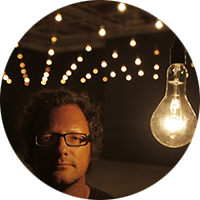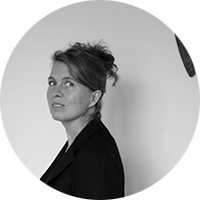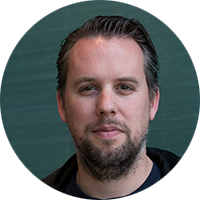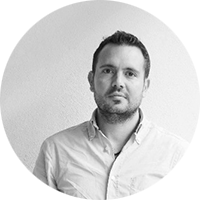

Keynote Speakers
|
Rafael Lozano-Hemmer Electronic Artist, Mexico City (link) Rafael Lozano-Hemmer was born in Mexico City in 1967. In 1989 he received a B.Sc. in Physical Chemistry from Concordia University in Montréal, Canada. Electronic artist, develops interactive installations that are at the intersection of architecture and performance art. His main interest is in creating platforms for public participation, by perverting technologies such as robotics, computerized surveillance or telematic networks. Inspired by phantasmagoria, carnival and animatronics, his light and shadow works are "antimonuments for alien agency". His large-scale interactive installations have been commissioned for events such as the Millennium Celebrations in Mexico City (1999), the Cultural Capital of Europe in Rotterdam (2001), the UN World Summit of Cities in Lyon (2003), the opening of the YCAM Center in Japan (2003), the Expansion of the European Union in Dublin (2004), the memorial for the Tlatelolco Student Massacre in Mexico City (2008), the Winter Olympics in Vancouver (2010), and the pre-opening exhibition of the Guggenheim in Abu Dhabi (2015). Recently the subject of solo exhibitions at the San Francisco Museum of Modern Art, the MUAC Museum in Mexico City, and the Museum of Contemporary Art in Sydney, he was the first artist to officially represent Mexico at the Venice Biennale with a solo exhibition at Palazzo Soranzo Van Axel in 2007. He has also shown at Art Biennials and Triennials in Havana, Istanbul, Kochi, Liverpool, Montréal, Moscow, New Orleans, Seville, Seoul, Shanghai, Singapore and Sydney. Collections holding his work include the MoMA in New York, Tate in London, AGO in Toronto, CIFO in Miami, Jumex in Mexico City, DAROS in Zurich, Borusan Contemporary in Istanbul, MUAC in Mexico City, 21st Century Museum of Art in Kanazawa, MAG in Manchester, MUSAC in Leon, MONA in Hobart, ZKM in Karlsruhe, MAC in Montréal and SAM in Singapore, among others. He has received two BAFTA British Academy Awards for Interactive Art in London, a Golden Nica at the Prix Ars Electronica in Austria, "Artist of the year" Rave Award from Wired Magazine, a Rockefeller fellowship, the Trophée des Lumières in Lyon, an International Bauhaus Award in Dessau, the title of Compagnon des Arts et des Lettres du Québec in Quebec, and the Governor General's Award in Canada. He has lectured at Goldsmiths college, the Bartlett school, Princeton, Harvard, UC Berkeley, Cooper Union, USC, MIT MediaLab, Guggenheim Museum, LA MOCA, Netherlands Architecture Institute, Cornell, UPenn, SCAD, Danish Architecture Cente, CCA in Montreal, ICA in London and the Art Institute of Chicago. |
|
Francesca Hughes Professor and Head of School, UTS Sydney (link) Francesca Hughes is a writer and educator in architecture who has more than 25 years experience teaching both design and history and theory at the Architectural Association and the Bartlett School of Architecture, U.C.L. She has recently been appointed professor of Architecture at UTS Sydney where she takes up the position of head of school in October. Francesca is author editor of The Architect: Reconstructing her Practice (MIT Press, 1996), Drawings that Count (AA publications, 2013) and most recently, author of The Architecture of Error: Matter, Measure and the Misadventures of Precision (MIT Press, 2014). She has lectured widely on architecture’s fetishisation of precision and thus complicated relations to computation in the US, Australia and Europe, including at e-flux New York, The Berlage, Princeton, Yale, MIT, Harvard and the London Science Museum. Francesca is co-founder of the multidisciplinary practice Hughes Meyer Studio, with American artist/ecologist Jonathan Meyer and Hungarian architect/digital artist Gergely Kovàcs, whose work has been extensively published by AA Files, AD, ANY, AR, A/R/P/A, Artforum, Harvard Design Magazine, e-flux, Merrell, Random House (Monacelli), Routledge, University of Minnesota Press and Wiley and exhibited in the UK and abroad. The studio’s recent collaborations have included a book with classicist Mary Beard and historian of science David Edgerton, and an Arts Council of Great Britain funded film with Turner Prize nominee Catherine Yass. Francesca’s forthcoming book examines architecture’s role in the histoire longue durée of computation, tentatively entitled, Architecture’s Computer: a Spatial Prehistory of the Universal Discrete Machine. |
|
Philippe Block Professor, Institute of Technology in Architecture at ETH Zurich (link) Philippe Block is Professor at the Institute of Technology in Architecture at ETH Zurich, where he directs the Block Research Group (BRG) together with Tom Van Mele. The BRG focuses on equilibrium analysis, computational form finding, optimisation and fabrication of curved surface structures, specialising in unreinforced masonry vaults and thin concrete shells. Prof. Block is also the director of the Swiss National Centre of Competence in Research (NCCR) Digital Fabrication. Within the NCCR, the BRG develops innovative structural design strategies using bespoke prefabrication, pushing construction innovation. Block studied architecture and structural engineering at the VUB in Belgium, and at MIT in the USA, where he earned his PhD in 2009. With the BRG and as partner of Ochsendorf DeJong & Block (ODB Engineering), he applies his research into practice on the structural assessment of historic monuments and the design and engineering of novel shell structures. He has won numerous awards for his research and work, including most recently the Berlin Arts Prize 2018 for Architecture. Block has lectured at top universities and leading engineering and architecture offices worldwide and is regularly invited as an expert consultant. |
|
Diego Ricalde Professor, Universidad Iberoamericana CDMX (link) Professor, Universidad Iberoamericana CDMX, principal at Estudio MMX. Diego Ricalde holds an Architecture BA from UNAM and an Architecture and Urbanism MArch from the Architectural Association. Diego is, currently, Professor at Universidad Iberoamericana, where he leads “Cátedra Blanca”; a diploma design studio focused on studying territorial and landscape dynamics and exploring the complexities of Mexico City’s basin through the incorporation of diverse digital tools and logics. Ricalde has lectured and taught in diverse universities, in Mexico and abroad, concentrating in digital logics and their relation to Mexico’s urban fabrics, architecture and fabrication processes. Along with three partners, he leads Estudio MMX; a practice based in Mexico City, interested in generating strategic design for a wide range of scales. Awards of Estudio MMX include the AIA Architectural League Prize and The National and International Cemex Award; the studio work has been exhibited at the Storefront, MoMa, Mude in Lisbon and Palacio de Bellas Artes. |
Special Guest Speaker
|
Patrik Schumacher Patrik Schumacher is principal of Zaha Hadid Architects and is leading the firm since Zaha Hadid’s passing in March 2016. He joined Zaha Hadid in 1988 and was seminal in developing Zaha Hadid Architects to become a 400 strong global architecture and design brand. Patrik Schumacher studied philosophy, mathematics and architecture in Bonn, Stuttgart and London. He received his Diploma in architecture in 1990. He has been a partner since 2003 and a co-author on all projects. In 2010 Patrik Schumacher won the Royal Institute of British Architects’ Stirling Prize for excellence in architecture together with Zaha Hadid, for MAXXI, the National Italian Museum for Art and Architecture of the 21st century in Rome. He is an academician of the Berlin Academy of Arts. In 1996 he founded the Design Research Laboratory at the Architectural Association in London where he continues to teach. In 1999 he completed his PHD at the Institute for Cultural Science, Klagenfurt University. Patrik Schumacher is lecturing worldwide and is currently a guest professor at Harvard’s GSD. Over the last 20 years he has contributed over 100 articles to architectural journals and anthologies. In 2008 he coined the phrase Parametricism and has since published a series of manifestos promoting Parametricism as the new epochal style for the 21st century. In 2010/2012 he published his two-volume theoretical opus magnum “The Autopoiesis of Architecture”. Patrik Schumacher is widely recognized as one of the most prominent thought leaders within the fields of architecture, urbanism and design. |




